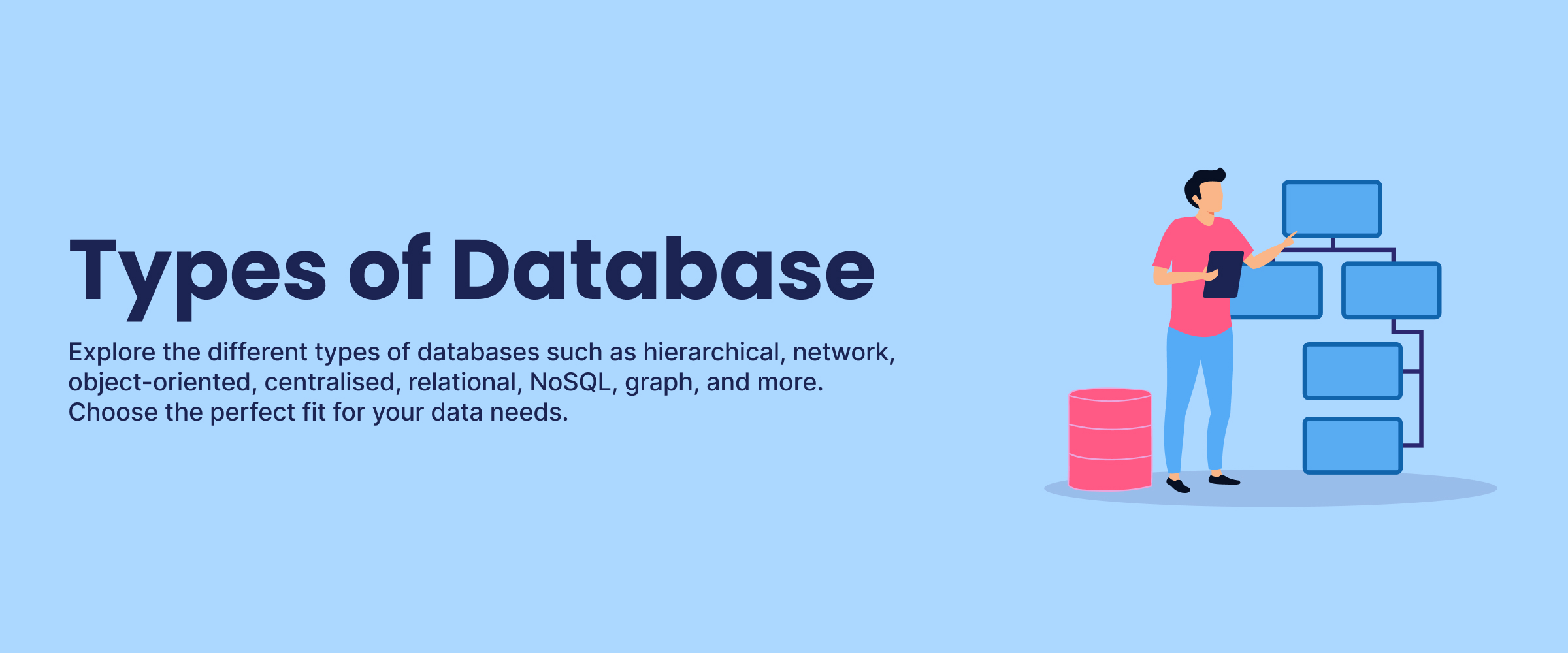Types of Databases: A Comprehensive Overview
In today’s data-driven world, databases play a pivotal role in managing, storing, and retrieving vast amounts of information. However, there isn’t a one-size-fits-all solution for databases, as their design and functionality vary based on specific requirements. In this blog, we will look into the various types of databases, from traditional relational databases to distributed databases.
What are Databases?
Think of databases as organized containers for different types of information. They help store lots of data like text, numbers, and pictures in a way that makes it easy for computers to find and work with that information. They are like organized filing cabinets that businesses and systems use to keep track of all kinds of stuff, from basic records to more complicated things like analyzing data.
Get a confirmed ₹35,000 total stipend on your first internship with our data analyst course with placement.
Types of Databases
Databases are crucial tools for organizing and storing data in various applications. There are different types of database systems, each tailored to specific needs. Given below are some of the most common database types.
Relational Databases (RDBMS)
Relational databases are structured using tables with rows and columns, where each row represents a record and each column represents a field. The relationship between tables is established through keys, ensuring data integrity and consistency. The Structured Query Language (SQL) is commonly used to interact with and manipulate data in RDBMS.
NoSQL Databases
NoSQL databases, such as MongoDB and Cassandra, excel at handling diverse data types like documents, graphs, or key-value pairs. Their schema-less nature allows for easy adaptation to changing data structures. This flexibility is particularly useful for rapidly evolving applications and scenarios where data formats vary widely.
In-Memory Databases
In-memory databases leverage RAM for data storage, offering rapid access speeds due to the absence of disk I/O. This makes them ideal for time-sensitive applications like financial trading or real-time analytics. However, the limitation of in-memory databases lies in their cost-effectiveness for large datasets, as RAM can be expensive compared to traditional disk storage.
Time-Series Databases
Time-series databases are designed to efficiently manage data that is recorded and organized based on timestamps. They provide specialized capabilities for handling chronological data, which is particularly beneficial for scenarios involving real-time data streams such as sensor readings, IoT device measurements, and financial market fluctuations.
Column-Family Databases
Column-family databases, often used in big data applications, optimize write-intensive workloads by allowing efficient data storage and retrieval due to their column-oriented structure. This architecture aids in managing vast datasets while accommodating dynamic and evolving data schemas.
NewSQL Databases
NewSQL databases are designed to address the limitations of traditional relational databases when it comes to handling massive amounts of data and concurrent users. By adopting distributed architectures, they enable organizations to achieve high levels of scalability without sacrificing consistency, integrity, and reliability.
Object-Oriented Databases
Object-oriented databases provide a seamless way to persist and retrieve objects, maintaining the inherent structure and relationships of the data. This makes them a valuable choice for software systems that demand efficient handling of interconnected data entities.
Spatial Databases
Spatial databases are designed to handle data with a spatial component, like coordinates, shapes, and distances. They enable complex operations like spatial indexing, which accelerates queries involving proximity or containment. Common examples include PostGIS, Oracle Spatial, and Microsoft SQL Server with spatial extensions. These databases play a vital role in various fields, from urban planning to environmental analysis.
Distributed Databases
Distributed databases are designed to distribute data across multiple nodes or servers, enabling high availability, fault tolerance, and improved scalability. These databases can be either SQL or NoSQL and are often used in large-scale applications where data needs to be spread across different geographic locations or data centers.
Blockchain Databases
Blockchain databases, a subset of distributed databases, use a decentralized and tamper-evident data structure to ensure the security and immutability of data. Each record, known as a block, is linked to the previous one, creating a chain of blocks. Blockchain technology is commonly associated with cryptocurrencies.
Cloud Databases
Cloud databases are hosted on cloud platforms and provide scalable and flexible storage solutions. They eliminate the need for organizations to manage physical hardware and offer benefits such as automatic backups, scalability, and global accessibility.
Data Warehouses
Data warehouses are specialized databases designed for analytical processing and reporting. They consolidate data from various sources, transform it into a usable format, and provide tools for complex querying and analysis. They are crucial for making data-driven decisions in organizations.
Document-Store Databases
Document-store databases are part of the NoSQL family and are designed for managing semi-structured or unstructured data. They store data in documents, typically in formats like JSON or XML, making them suitable for applications that need flexibility in data structure.
Knowledge Graph Databases
Knowledge graph databases use a graph format with nodes representing entities and edges for relationships. They are ideal for managing complex, interconnected data, offering a human-friendly context. Such databases excel in recommendation systems, semantic search, and data integration. They enhance understanding and utilization of intricate data landscapes.
XML Databases
XML databases are purpose-built to natively manage XML data, making them ideal for storing and retrieving XML documents with complex hierarchies. These databases excel in applications involving XML data exchange, like web services. By preserving the inherent XML structure, they enhance query performance and data manipulation. This specialized approach streamlines XML-related tasks.
Embedded Databases
Embedded databases are lightweight databases integrated directly into applications, useful when a standalone system isn’t needed. They provide local storage, enhance data management within the application, and offer quick data access, eliminating remote server communication. Due to their efficiency, they are ideal for resource-limited environments, simplifying deployment and reducing complexity.
Memory-Mapped Databases
Memory-mapped databases offer a high-performance solution by mapping disk-stored data into the application’s memory. This minimizes the need for traditional I/O operations, leading to quicker data access. Furthermore, this method benefits from the inherent memory management of the operating system, making it suitable for managing extensive datasets efficiently.
Hierarchical Databases
Hierarchical databases arrange data in a tree-like structure with parent-child relationships. They were common in early computing for file systems and charts. They have limitations in handling complex relationships, leading to the popularity of relational databases. Today, they are still used in specific scenarios where data naturally fits this structure.


Real-World Applications of Databases
Real-world applications of databases are abundant and diverse, impacting various industries. Here are three prime examples of their utilization.
E-Commerce Systems
Databases play a crucial role in e-commerce systems by storing and managing product information, customer profiles, order histories, and transaction records. These systems require efficient and reliable databases to handle high volumes of data, ensure accurate inventory management, process orders, track shipments, and provide personalized recommendations to users.
Healthcare Management
In healthcare, databases are used to store and manage patient records, medical histories, diagnostic results, treatment plans, and scheduling information. Electronic Health Records (EHR) systems rely on databases to maintain a comprehensive and accessible medical history for each patient, enabling healthcare providers to make informed decisions and coordinate care effectively.
Social Media Platforms
Social media platforms utilize databases to handle user profiles, posts, comments, likes, and connections. These platforms deal with massive amounts of data generated by millions of users, requiring databases to efficiently manage and retrieve information for user feeds, notifications, search functionality, and personalization algorithms.
You can learn more about databases and their functions through this in-depth SQL course.
Conclusion
There are different types of databases and choosing the right database type is crucial for an application’s performance and functionality. Different types cater to specific needs, such as structured, unstructured, time-series, or spatial data. Staying informed about evolving technology helps developers make informed decisions, and adapting to emerging challenges ensures efficient data handling in a dynamic tech landscape.







